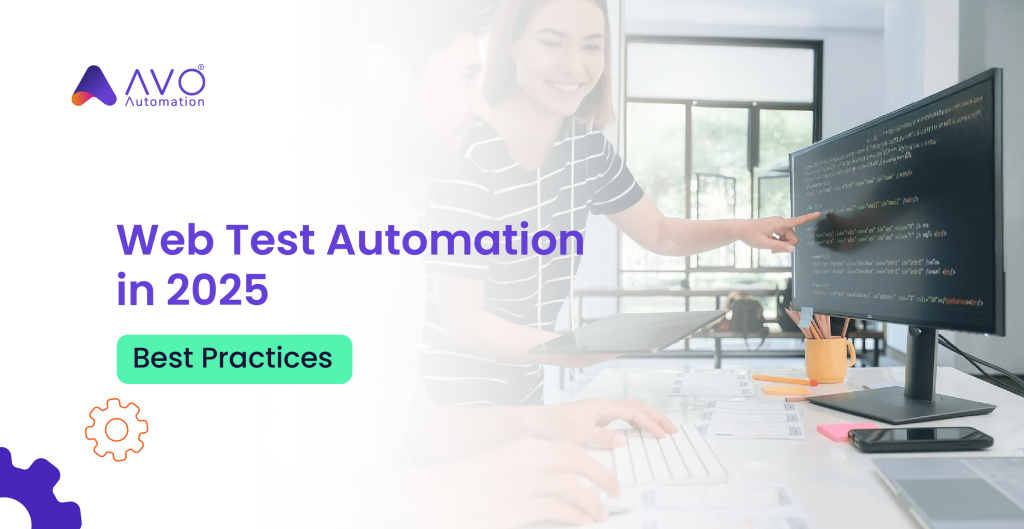Introduction
As digital experiences continue to evolve, ensuring seamless web application performance has become critical. Web test automation has rapidly advanced, integrating AI, cloud-based testing, and continuous testing methodologies. In 2025, adopting the right test automation strategies can help businesses achieve faster releases, improved software quality, and enhanced user experiences.
This blog explores the best practices for web test automation in 2025, helping QA teams, developers, and businesses optimize their testing efforts.
1. Embrace AI-Powered Test Automation
Artificial intelligence (AI) and machine learning (ML) are revolutionizing test automation. AI-powered testing tools can:
- Self-heal test scripts by automatically updating locators when UI elements change.
- Improve test coverage by identifying gaps in existing test cases.
- Predict failures using historical data to suggest risk-based testing.
- Accelerate test execution with smart prioritization.
- Best Practice: Leverage AI-driven tools like Avo Assure, Testim, and Applitools to enhance test reliability and efficiency.
Related Reading: Agentic AI & Test Automation: A Strategic Leap Forward for Enterprises
2. Shift-Left Testing for Faster Defect Detection
Shift-left testing integrates automated testing early in the development cycle, reducing costs and catching defects sooner. This approach aligns with Agile and DevOps principles.
Best Practice:
- Implement test automation in CI/CD pipelines.
- Automate unit and API tests alongside UI tests.
- Use static code analysis and linting tools to identify issues early.
3. Optimize Test Automation Frameworks
A robust test automation framework ensures maintainability and scalability. In 2025, key considerations include:
Modular architecture: Promotes reusability and reduces redundancy.
- Data-driven testing: Enhances test coverage using different input sets.
- Keyword-driven testing: Simplifies test creation with pre-defined keywords.
- Parallel execution: Accelerates test cycles by running tests simultaneously.
Best Practice: Choose modern frameworks like Selenium WebDriver, Cypress, Playwright, and WebDriverIO, depending on project requirements.
4. Implement Cloud-Based and Cross-Browser Testing
With diverse devices and browsers in use, cloud-based test automation is essential for scalability and real-world accuracy.
Best Practice:
- Use cloud testing platforms like BrowserStack, Sauce Labs, or LambdaTest.
- Ensure tests run on multiple browser versions and OS configurations.
- Automate mobile-web testing alongside traditional web applications.
5. Integrate Continuous Testing in CI/CD Pipelines
Continuous Testing ensures quality at every stage of development. Automation integrated with CI/CD pipelines accelerates software delivery.
Best Practice:
- Automate tests for every code commit (smoke, regression, functional tests).
- Use tools like Jenkins, GitHub Actions, or GitLab CI/CD for seamless integration.
- Ensure real-time feedback through detailed test reports and dashboards.
Best Practices for Automated QA Testing | Enhance Software Quality with Test Automation
6. Leverage No-Code/Low-Code Test Automation
No-code and low-code automation tools empower non-technical testers to contribute to automation efforts, reducing dependency on developers.
Best Practice:
- Adopt tools like Avo Assure, TestProject, or Leapwork for scriptless automation.
- Enable business users and manual testers to create automated test cases.
- Combine codeless solutions with traditional scripting for maximum efficiency.
Related Reading: No Code Testing: Practical Tips for Non-Technical Testers
7. Prioritize Security and Compliance Testing
With increasing cybersecurity threats, automated security and compliance testing must be part of your strategy.
Best Practice:
- Integrate security scanning tools like OWASP ZAP, Burp Suite, or Snyk.
- Automate compliance checks for GDPR, DORA, HIPAA, and other regulations.
- Use API security testing tools to prevent vulnerabilities in web services.
8. Focus on Performance and Load Testing
Performance testing ensures web applications remain responsive under different traffic conditions.
Best Practice:
- Use tools like JMeter, Gatling, or k6 for automated load testing.
- Simulate real-world scenarios with virtual users to measure system performance.
- Integrate performance tests within CI/CD pipelines to monitor regressions.
9. Enhance Test Reporting and Analytics
Real-time reporting and analytics help teams make data-driven decisions and improve test effectiveness.
Best Practice:
- Use dashboards and reporting tools like Allure, ReportPortal, or TestRail.
- Implement test coverage metrics to track automation ROI.
- Leverage AI-based test analytics to identify trends and patterns.
10. Foster Collaboration Between Teams
Test automation thrives in an environment where developers, testers, and business analysts collaborate.
Best Practice:
- Encourage a TestOps approach, aligning QA with DevOps.
- Use collaboration tools like Jira, Slack, and Confluence for seamless communication.
- Conduct regular test automation reviews and retrospectives.
Conclusion
Web test automation in 2025 is evolving with AI, cloud testing, and DevOps-driven methodologies. By adopting these best practices, businesses can enhance software quality, reduce testing costs, and accelerate time to market.
Top Test Automation Trends for 2025
Why Avo Assure is the Ideal Choice for Web Testing
When it comes to web test automation, selecting the right tool is crucial. Avo Assure stands out with its unique combination of simplicity, intelligence, and efficiency, making it the perfect fit for modern testing needs.
What Makes Avo Assure Different?
🔹 Zero-Code Simplicity: Avo Assure enables business users, QA teams, and non-technical stakeholders to create and execute test cases without writing a single line of code. This empowers teams to scale automation effortlessly.
🤖 AI-Driven Efficiency: Built-in AI-powered self-healing capabilities minimize test maintenance by automatically adapting to UI changes, reducing flaky tests and increasing test stability.
🌍 Scalability Across Devices & Browsers: Avo Assure supports comprehensive cross-browser and cross-device testing, ensuring your web applications perform seamlessly across diverse environments.
⚡ Faster Implementation & Seamless Integrations: Pre-built test artifacts and out-of-the-box integrations with CI/CD tools like Jenkins, GitHub Actions, and Selenium Grid allow teams to set up automation quickly and efficiently.
🔄 Reusable & Modular Test Automation: Avo Assure allows teams to create reusable test components, reducing redundancy and improving maintainability.
Experience Avo Assure Firsthand
See how Avo Assure can transform your web testing strategy with intelligent automation and unparalleled ease of use. Schedule a demo today and take the first step toward efficient, AI-driven test automation.

